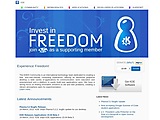 GNOME is a desktop environemnt and an application collection for BSD/Linux systems. It aims for accessibility and simplified interfaces. It utilizes the Gtk+/Gdk/Glib, Cairo/Clutter, WebKitGtk and GStreamer toolkits, Mutter as its window manager, also strongly integrates DBUS and Avahi, provides an adaptable Gnome shell, many productivity and system applications,and some games.
GNOME is a desktop environemnt and an application collection for BSD/Linux systems. It aims for accessibility and simplified interfaces. It utilizes the Gtk+/Gdk/Glib, Cairo/Clutter, WebKitGtk and GStreamer toolkits, Mutter as its window manager, also strongly integrates DBUS and Avahi, provides an adaptable Gnome shell, many productivity and system applications,and some games.
 Add checksums to Nautilus' properties window
Add checksums to Nautilus' properties window
 GNUIsance is a GTK4 library that aims to create a consistent repository of widgets and utilities that users might need only from time to time. By design, these can be accessed altogether (-lgnuisance), or it is possible to link only the single widgets required for an application (-lgnuitaggedentry, -lgnuiflow, etc.).
GNUIsance is a GTK4 library that aims to create a consistent repository of widgets and utilities that users might need only from time to time. By design, these can be accessed altogether (-lgnuisance), or it is possible to link only the single widgets required for an application (-lgnuitaggedentry, -lgnuiflow, etc.).
 A simple Nautilus extension that adds “Hide” and “Unhide” to Nautilus right-click menu. Nautilus Hide does not add a leading dot to file names, but relies on Nautilus' ability to hide the files that are listed in a .hidden file. The extension erases the .hidden files when these are empty and is able to handle selections of files that are distributed across multiple locations.
A simple Nautilus extension that adds “Hide” and “Unhide” to Nautilus right-click menu. Nautilus Hide does not add a leading dot to file names, but relies on Nautilus' ability to hide the files that are listed in a .hidden file. The extension erases the .hidden files when these are empty and is able to handle selections of files that are distributed across multiple locations.
 Univention Corporate Client (UCC) is a flexible and efficiently manageable operating system for PCs, notebooks, and thin clients in companies and institutions. The software contains a Linux-based desktop environment optimized for business use. It allows desktops to be adapted to hardware and intended applications. In addition, it can be managed conveniently and efficiently via a Web-based console. In comparison to other systems, it guarantees integrated administration procedures for users, clien
Univention Corporate Client (UCC) is a flexible and efficiently manageable operating system for PCs, notebooks, and thin clients in companies and institutions. The software contains a Linux-based desktop environment optimized for business use. It allows desktops to be adapted to hardware and intended applications. In addition, it can be managed conveniently and efficiently via a Web-based console. In comparison to other systems, it guarantees integrated administration procedures for users, clien
 Xfce is a desktop environment for X11 and Unix-like systems. It's comparatively lightweight and low on system resources, yet provides a modern and customizable interface. It includes a window manager, a panel and taskbar, file management, system and desktop setting tools, power management, intuitive virtual desktop switching, and a media player amongst other features.
Xfce is a desktop environment for X11 and Unix-like systems. It's comparatively lightweight and low on system resources, yet provides a modern and customizable interface. It includes a window manager, a panel and taskbar, file management, system and desktop setting tools, power management, intuitive virtual desktop switching, and a media player amongst other features.
 Plasma is the desktop component of KDE. It's shell is modularly designed and can harbour nested applets and widgets besides traditional icon shortcuts. It's based entirely on Qt5 with QML (Qt modeling language), KDE Frameworks 5, and OpenGL rendering.
Plasma is the desktop component of KDE. It's shell is modularly designed and can harbour nested applets and widgets besides traditional icon shortcuts. It's based entirely on Qt5 with QML (Qt modeling language), KDE Frameworks 5, and OpenGL rendering.
 For users on Linux and Unix, KDE offers a full suite of user workspace applications which allow interaction with these operating systems in a modern, graphical user interface. This includes Plasma Desktop, KDE's innovative and powerful desktop interface. Other workspace applications are included to aid with system configuration, running programs, or interacting with hardware devices. While the fully integrated KDE Workspaces are only available on Linux and Unix, some of these features are availa
For users on Linux and Unix, KDE offers a full suite of user workspace applications which allow interaction with these operating systems in a modern, graphical user interface. This includes Plasma Desktop, KDE's innovative and powerful desktop interface. Other workspace applications are included to aid with system configuration, running programs, or interacting with hardware devices. While the fully integrated KDE Workspaces are only available on Linux and Unix, some of these features are availa
|